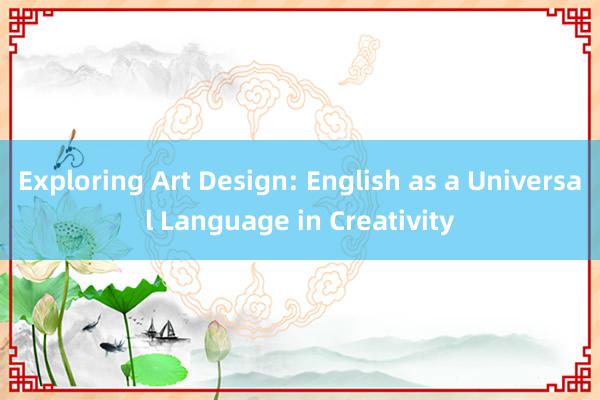-
Exploring Art Design: English as a Universal Language in Creativity

### Exploring Art Design: English as a Universal Language in Creativity
In the vast tapestry of human creativity, language serves as both a barrier and a bridge. As we navigate the world of art design, one language stands out for its universal appeal: English. This article delves into how English facilitates global communication in the realm of creativity, examining its role in fostering international collaboration, standardizing terminology, and promoting a shared understanding across diverse cultures.
#### The Role of English in Global Collaboration
English acts as a lingua franca in the creative industries, enabling designers from different countries to collaborate seamlessly. For instance, when an Italian designer works on a project with a team from Japan, they can rely on English to convey complex ideas, technical specifications, and creative visions without the need for extensive translation services. This not only saves time but also ensures that the nuances of design concepts are preserved across linguistic boundaries.
#### Standardization of Terminology
In the intricate field of art design, precise terminology is crucial for effective communication. English provides a common ground where terms such as "color theory,新乡泵阀网 - 泵阀行业门户 泵阀生意人" "user experience, 海口市香克美百货店" or "brand identity" are understood universally. This standardization reduces confusion and facilitates the exchange of knowledge among designers worldwide. Whether discussing color palettes, 上海市闵行区郑晓宇饺子店 layout principles, or digital design tools, English allows for a clear and consistent dialogue.
#### Promoting Cultural Exchange
English transcends cultural barriers,日常学习信息汇总 allowing artists and designers to draw inspiration from a wide array of sources. From the intricate patterns of Islamic art to the bold typography of Chinese design, English enables creators to explore these influences without linguistic constraints. This cross-cultural exchange enriches the design landscape, blending traditional aesthetics with modern techniques and technologies.
九千配置网#### Challenges and Opportunities
While English offers numerous advantages in the realm of art design, it also presents challenges. Non-native speakers might struggle with the specialized vocabulary or the rapid evolution of design jargon. Moreover, the dominance of English can sometimes overshadow local languages and artistic traditions, potentially leading to a homogenization of creative expressions.
#### Embracing Diversity and Inclusion
To address these challenges, the design community must actively promote multilingualism and inclusivity. Encouraging the use of local languages in creative projects not only respects cultural diversity but also broadens the pool of creative voices. By integrating local languages with English, designers can create more nuanced and culturally rich works that resonate with a global audience.
#### Conclusion
English, as a universal language in creativity, plays a pivotal role in connecting designers across the globe. It streamlines collaboration, standardizes terminology, and promotes cultural exchange. However日常学习信息汇总, recognizing and embracing linguistic diversity is essential for fostering innovation and maintaining the richness of artistic expression. As the world continues to evolve, so too must our approach to language in the arts, ensuring that creativity remains accessible, inclusive, and vibrant for all.
- 上一篇:高效设计管理:制定详细进度计划表
- 下一篇:没有了
